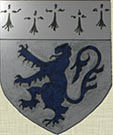 |
SKELTON - IN - CLEVELAND
IN HISTORY
|
 |
"WE WILL REMEMBER THEM"
SS/111447 Stoker 1st Class JOHN WILLIAM PARKER
H.M.S. "Queen Mary.", Royal Navy.
Died on the 31st May 1916.
Son of Joseph and the late Annie Parker, of 21 William St, North Skelton-in-Cleveland, Yorks.
|

Portsmouth Naval Memorial.
|
FAMILY:-
1901. John was age 10 and living at 21 William St, North Skelton, where he had been born.
His father, Joseph, aged 35, was an Ironstone miner, below ground. He had been born in Bilsdale, N Yorks.
His mother, Annie, aged 40. was born in Faceby, N Yorks.
He had an elder brother, also Joseph, who was already working down the mine, age 14, as a Rapper.
He had two other brothers, Frank 9 and Thomas 3 and two sisters Mary 12 and Sarah 6.
|

|

|
WAR SITUATION.
HMS Queen Mary was a Battlecruiser which had seen action from the start of the War.
On August 28th it was in a raid on the German coast that sank 2 of their ships, the Coln and Ariadne.
In December 1915 it took part in an attempt to ambush the Germans as they conducted a raid on the North East coast, but they escaped.
In May, British naval intelligence learned that the German High Seas Fleet had left port.
Steaming in advance of Admiral Sir John Jellicoe's Grand Fleet, Beatty's battlecruisers, supported by the battleships of the 5th Battle Squadron, collided with Vice Admiral Franz Hipper's battlecruisers in the opening phases of the Battle of Jutland.
Engaging at 3:48 PM on May 31, the German fire proved accurate from the outset.
At 3:50 PM, Queen Mary opened fire on SMS Seydlitz with its forward turrets.
As Beatty closed the range, Queen Mary scored two hits on its opponent and disabled one of Seydlitz's aft turrets.
Around 4:15, HMS Lion came under intense fire from Hipper's ships.
The smoke from this obscured HMS Princess Royal forcing SMS Derfflinger to shift its fire to Queen Mary.
|
As this new enemy engaged, the British ship continued to trade hits with Seydlitz.
At 4:26 PM, a shell from Derfflinger struck Queen Mary detonating one or both of its forward magazines.
The resulting explosion broke the battlecruiser in half near its foremast.
A second shell from Derfflinger may have hit further aft.
As the after part of the ship began to roll, it was rocked by large explosion before sinking.
Of Queen Mary's crew, 1,266 were lost while only twenty were rescued.
Though Jutland resulted in a strategic victory for the British, it saw two battlecruisers, HMS Indefatigable and Queen Mary, lost with nearly all hands.
An investigation into the losses led to changes in ammunition handling aboard British ships as the report showed that cordite handling practices may have contributed to the loss of the two battlecruisers.

HMS Queen Mary, sunk at the Battle of Jutland.
MEMORIAL:-
John is commemorated on the Portsmouth Naval Memorial which bears the names of some 10,000 Sailors of the First World War.
|
|